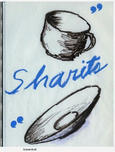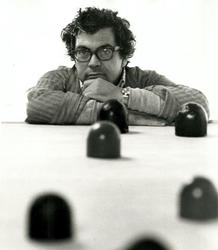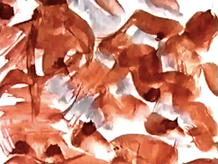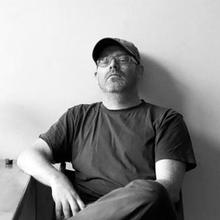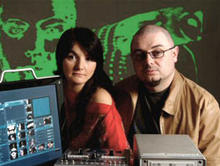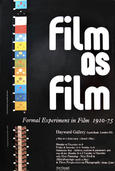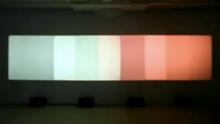69
(1968)by Robert Breer oscillates the title image through positive and negative figure/ ground flicker, creating afterimages that seem to float in front of the screen.
JONAS MEKAS: I don’t know if it will work, but ideally I’d like to concentrate only on your last three films, 66, 69 and 70. I think that they differ from all the others. Or no? What do you think? Do they differ, for you?
ROBERT BREER: Yes, they do. But you know, Form Phases IV is very much like those films. Form Phases IV was made in 1956 or something, and tha was my last abstract film until the film 66 which was in 1966 or 1967. In between, I made those collage and animated cartoons and people films. 66 was very much a return to Form Phases IV. It’s a funny kind of retrogression, I guess. 66 was purely geometric, abstract. 69 was another abstraction; and then, 70. They have numbers and they group together, developments of each other, I guess.
MEKAS: Most of your films before 66, I mean the period between 1960 and 1966, deal with certain collage areas-even the films with people. They don’t go that deeply into the explorations, in a sort of minimal way, of color, the illusions of the eye, the… I don’t know how to describe it.
BREER: But that’s where I started. My first film, Form Phases I, in 1952, as a matter of fact, it’s an abstract film. That is an abstract film, and it came right out of my paintings and elements in it were taken from my paintings. In fact, it was meant to be just an elaboration on the painting I was working on at the time. I wasn’t really interested in film; I didn’t know if I was. So now I am going back to that again. I don’t paint anymore. Oh, I fell into a certain dead end in the painting, at that time, and the neo-plastic ideal. Films were very liberating, so I took advantage of it. I wanted to see some things I’d never seen before. Actually, those collage films were in the same spirit as the abstract paintings, trying to distill the essence of the medium. For me, film was another medium that permitted mixing all this other extraneous stuff, ideas and words and configurative elements that I couldn’t justify putting in paintings anymore, and I was sort of trying to come to terms with conventional cinema as opposed to film, but still, very basically, abstract, you know, examining the material, what was possible in film. So now, I’ve come back.
(No. 56-57 Spring 1973 issue of Film Culture)
Source: Film Culture
In 69 the title image oscillates through positive and negative figure/ground flicker, creating afterimages that seem to float in front of the screen. The film proper begins with a line drawn hexahedron rod on white background rotating into frame on the left and moving away from the viewer. Other shapes go through similar arcs of movement. A conventional 3-D perspective is respected in these shapes and movements and there is the precision of an architectural drawing to the imagery at this early stage of the film. The motion effect is like the movements of the rods on a locomotive wheel, yet highly stylised and abstracted. This rotation sequence is repeated throughout the film in various permutations. In the next cluster the line shapes become blocks of colour, then a mixture of line and colour, then with a darker blue background.
Now and then there are bursts of single frame abstractions flickering and flashing. This palimpsest of forms flickers across the original in a repeating, yet disintegrating sequence. The sounds are very mechanical, a phone like repeating click, a tick-tick sound and the sound of switching between stations on a radio reflect these indeterminacies and breakdowns. 69 ends with its opening sequence. The film can be read as a loop, now ready to begin again.
What one sees in such a Breer film is not what is actually physically on the film-strip but the fleeting product of the film’s performance on the retina. The velocity of Robert Breer’s sensory manipulations generally defies any kind of assessment, or thinking through while watching them. These films are designed as a cavalcade of visual impressions. Thinking can only come after the event. This is a critical point that eternally re-surfaces when describing Robert Breer’s films.
Breer says of 69 that: "69 undoes itself. It starts out like a system, then the system breaks down and goes to hell. During the editing I came up with the idea that it should break down, so I shuffled the cards. I thought it served me right to undo my own pretence at formal purity" (MacDonald, 1992: 43). Breer here articulates a critical act of irreversibility: "In shuffling the cards I could never get them back in their proper order again. They weren’t numbered" (Griffiths, 1985). Like the breadcrumbs that Hansel and Gretel drop to leave a trace back out of the forest that then gets erased by being eaten by the birds: there is no way back. Yet we can watch the animation again. In this continual moving away from the originating material in both sequence and form arises this notion of a further displaced trace of a trace (of a trace), which can be considered an approximation of Elsaesser’s event without a trace.
("Performing a Traumatic Effect – The Films of Robert Breer" by Dirk de Bruyn)
Source: Animation Studies
